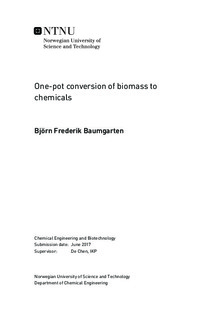| dc.description.abstract | One-pot conversion of biomass to diols can be a simple and fast alternative to other methods of biomass conversion. The catalyst for this conversion is required to be bifunctional, catalysing both hydrogenation and retro-aldol condensations. Hydrogenation is realized by usage of transition metals like Ru, Ni and alternativly copper. Retro-aldol condensations are catalyzed by various tungsten compounds, amphoteric and basic metal oxides or basic sites.
New amphoteric and basic catalysts were tested, La2O3, MgO, Al2O3 and nitrogen doped carbon spheres. The metal oxides were dispersed on carbon nano tubes and copper as hydrogenation catalyst added, while the carbon spheres were used as support and copper dispersed on them.
La2O3 proved to be the most promising catalyst with yields of 20,3% ethylene glycol and 18,1% PG.
In order to demonstrate the importance of optimizing the ratio between hydrogenation and retro-aldol condensation catalyst, additives which are solely active for one function were added. Thereby, it was possible to show that La2O3 is very active for retro-aldol condensations and more hydrogenation catalyst is required. With hydrogenation additive, a yield of 28,2% EG and 19,2% PG could be reached.
By usage of the additives and a novel liquid sampling mechanism enabling sampling mid-reaction, more insight into the reaction mechanism could be gained. Indicators for too strong activities of both reactions could be identified.
Too high hydrogenation activity is indicated by formation of persistent erythritol and sorbitol amounts. In contrast, forming of small sorbitol amounts and subsequent consumption during the reaction is desired and limits the amount of degradation products.
Too high retro-aldol condensation activity leads to the formation of 5-HMF degradation and polymerisation, manifesting in a large void volume peak.
Additionally, the reaction network could be completed and adjusted for copper-based hydrogenation catalysts. | |

